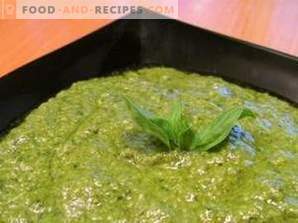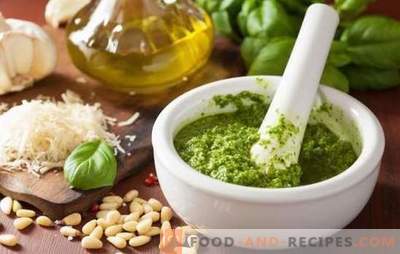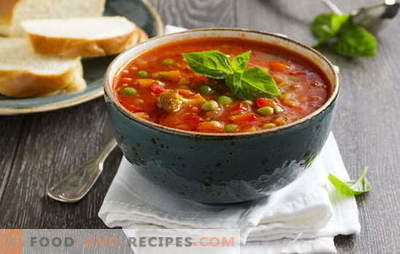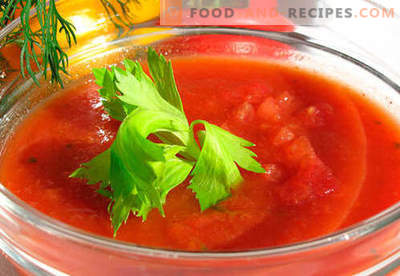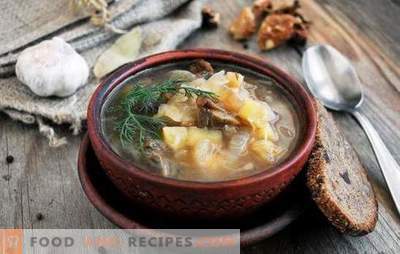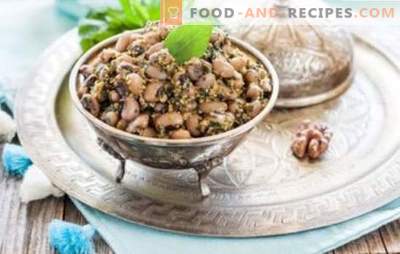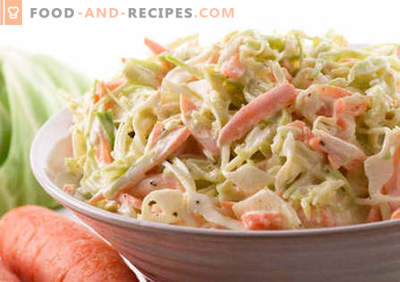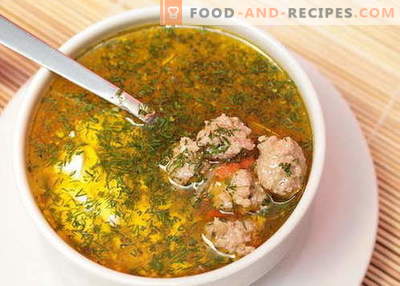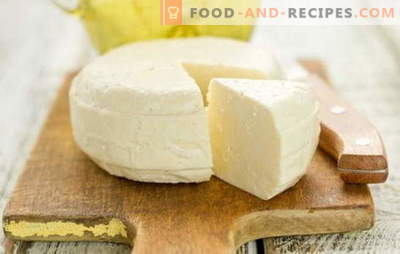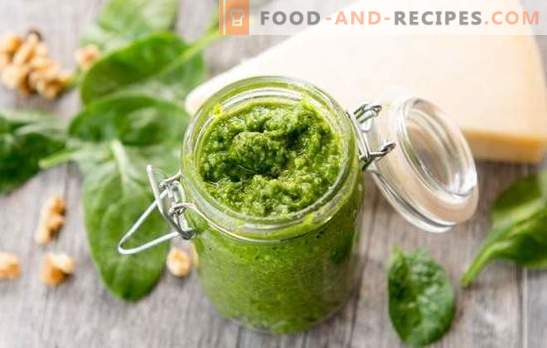
It seems that there is no such country and no such people who would not be proud of their culinary discoveries, and if it speaks of sauces, this is an endless topic. At first glance, the repetitive composition of spices and herbs, which has already flown around the world. No new spices are open, but for some reason, basil in Thailand and Italy has a completely different taste. And the matter is not in the varietal variety of leafy vegetables, but in the methods of its preparation, in combinations.
Once on the fertile land of the Apennine Peninsula, Asian culture has become the main ingredient of Italian, Greek and French sauces. If only this, but she got a completely new taste in these dishes.
Genoese basil, pine nuts (pine) or pine nuts, olive oil and cheese are all components of the sauce, which conquered the culinary world and glorified all of Italy, and especially Liguria. It would seem, take it and do - nothing complicated! But do not rush, because everyone has their own secrets, and most importantly: do not forget to praise all Italians for the fact that pesto was invented by their compatriot in order to respect the temperamental southern people.
Classic pesto sauce - basic technological principles
To cook real Ligurian pesto, you have to be patient, knowledge and necessary products, or information, where they can be obtained, or what to replace. In principle, green and even red sauce of the same name can be made from another variety of basil, but it will be another pesto, also classic, but with a different flavor. In Liguria, they are very proud of the original recipe, and if someone dares to arrogate to himself the glory of the famous sauce, to which the festival is annually dedicated, the Ligurians will be offended. Therefore, the first, most original recipe, described below, try to prepare exactly to appreciate the subject of pride of Genoa.
What you need to remember about pesto sauce? The classic composition is cedar nuts or pine pines, an essential ingredient is extra virgin olive oil, cheese - Parmesan or Pecorino Sardo. It is clear that difficulties will immediately arise with cheese. You will not get such a cheese as it should, pick the hardest of cheeses, preferably from sheep's milk. This is the most famous Ligurian pesto, and all the other classical variants are also its derivatives. It is believed that pesto is a green sauce, and in a sense it is true. Firstly, the very first of the sauces of this type had a really bright, very saturated green color, and secondly, if we consider that the sauce is made from fresh greens, how can we call it differently if not green? But even in Italy pesto sauces appeared red, there is pink and yellow pesto.
Identical sauces are prepared in Provence, Austria, Germany. The composition of these sauces is vaguely similar to the very first pesto recipe, but even better. Especially if you take into account the etymology of the name, then there is nothing seditious about such changes: “pesto”, translated from Italian, to be pounded or pounded. That is, the name directly indicates the method of preparation, and not the composition of the ingredients.
Indeed, initially the sauces were prepared in a mortar, they were ground to a pasty state. Probably because there were no blenders, combines and other shredders in those days. True, some professionals argue that the contact with metal knives deteriorates the properties of basil, because this delicate green does not tolerate contact with the metal.
With this statement it is possible to argue. First, there are ceramic knives, and basil can be simply chopped up with such a knife. Secondly, grinding in a mortar is a long and exhausting process, and, to be honest, even professionals rarely resort to this method of cooking green sauce. Thirdly, when it comes into contact with oxygen, basil also oxidizes very quickly when it needs to be pounded in a mortar for a very long time — much faster than in a blender, when it is punched for not more than a minute. Fourthly, if basil is quickly immersed in oil, neither metal knives nor air oxidation can spoil basil.
These are, in fact, all the subtleties that you need to know about cooking pesto.
What does it eat? Of course, with pasta! You can add italian pizza, Russian pies, vegetable appetizers and salads, soups, or just spread a sandwich.
1. Classic pesto sauce - cooked as in Liguria
Ingredients:
Pine nuts 15 g
Olive oil (first spin) 80 ml
Basil, green Genoese 40 g
Garlic 5-6 g (1 tooth)
Parmesan cheese 75 g
Salt
Cooking:
Crush nuts and garlic by adding a pinch of salt. Pour butter into the nut mass, punch all the ingredients with a blender. Tear the basil hands, as small as possible, immerse in a blender, punch the sauce again. Add cheese, grated on the finest grater.
The sauce is ready.
2. Classic pesto sauce - version two, Sicilian
Ingredients:
Basil 80g
Tomatoes fresh 100 g
Sun dried tomatoes 50 g
Garlic 10 g
Almond 120g
Olive oil 70 ml
Cooking:
Fresh, medium-sized tomato blanch, remove the skin and seeds. Tear the basil, peel a couple cloves of garlic. Immerse all ingredients in a blender and punch to a smooth consistency.
The good news: in this recipe, you can use dried oregano instead of basil, in the winter version of the recipe. This sauce can be stored for a long time, in the refrigerator. Dry oregano must be added twice as much as fresh basil.
3. Pesto Sauce - a classic recipe from Provence
Ingredients:
Olive oil and water 50 ml
Basil 100 g
Garlic
Salt
Cooking:
Pour the oil into a blender, whip at high speed, gradually adding cold boiled water. When the mass turns into an emulsion, add basil and garlic. Continue punching until smooth.
This sauce is added to soups.
4. Pesto sauce - classic in Germany
Ingredients:
Cedar nuts 70 g
Ramson 120g
Cheese 150 g
Olive oil 80 g
Cooking:
Fry nuts, chop the ramson. Put all ingredients in a blender and perebeyte to a puree consistency.
5. Classic pesto sauce with lemon
Ingredients:
The composition of products - according to the recipe №1 + 1/2 lemon
Cooking:
Repeat the entire cooking process exactly as described in the first recipe, but add the juice and zest of half a lemon to the blender bowl.
This sauce is perfect for salted fish sandwiches.
6. Classic pesto sauce with avocado
Ingredients:
Lime 1/2 pcs.
Avocado, medium 1 pc.
Basil 50g
Mint 30 g
Oil 120 g
Garlic 15g
Cheese 100 g
Salt
Cooking:
Peel the avocado by removing the bone. Put in a blender, add garlic, lime juice, butter, greens. Punch until smooth. Salt to taste, add grated cheese.
7. Classic pesto sauce for baked eggplant rolls
Ingredients:
Cheese 120g
Basil, purple 70 g
Parsley 40 g
Garlic 20g
Cilantro 40g
Oil 150 g
Nuts 150 g
Salt
Hot pepper (green) 1/2 pod
Lemon 1 pc.
Eggplant 3 pcs.
Flour 50 g
Egg 1 pc.
Water 80 ml
Frying oil
Cooking:
Wash eggplants, soak in water to remove bitterness, slice lengthwise, no more than 0.5 cm thick. Prepare the mixture from flour, eggs and water. Cover the baking sheet with foil, brush with oil. Lay the eggplant plates, brush them with the top of the cooked lezon, and bake until golden brown. When fry, flip the other side, cover with another sheet of foil on top. Let cool.
Remove the zest from the lemon, squeeze the juice into a blender. Add all the other ingredients and punch in pulsation mode to obtain a paste. Spread the prepared plates with it, wrap it with a roll, put it on a baking sheet, seam down. Lubricate the rolls on top with Lyezon, and bake in the open form, again until rosy color. Serve cold or hot with sour cream.
8. Classic pesto sauce for carrot soup
Ingredients:
Carrots 400 g
Onion 200 g
Cream 250 ml
Broth, chicken 0.5 l
Flour 90 g
Butter 120g
Salt
Sugar
White pepper
For the sauce:
Basil 50g
Oil 100 g
Cilantro 50g
Pumpkin seeds, peeled 120 g
Garlic 20g
Lemon 1/2 pc.
Cooking:
Prepared vegetables, onions and carrots, chop into slices. Sprinkle lightly with sugar and salt. Hold in a hot oven until soft. Put in a saucepan, cover with warm chicken broth. Boil until boiling. Melt butter in a frying pan, add flour and fry until cream color. Stir-fry flour and warm cream, add to pan. Punch the soup with a blender until smooth. Serve with a spoonful of sauce.
For the sauce, fry the seeds, add butter, lemon juice, garlic and spicy greens. Punch the mass to a pasty consistency.
Classic pesto sauce - useful tips.
Do not cook sauce for future use. It is used raw, without heat treatment. After standing a little, the sauce will lose its flavor, and crushed basil loses its appearance and useful properties, being oxidized under the influence of oxygen. That is, having prepared pesto a couple of hours before use, do not forget to put it in a jar and close it tightly. Clean in a dark cool place.
What to do if it was not possible to get the same famous variety of fragrant basil, with the smell of lemon, anise and mint? There is a simple way out: add lemon zest, starved star anise to the sauce, a little pinch, and a little mint, and use the basil that is available. But there is another way, longer, but guaranteed to provide the right greenery at the right time: basil for pesto in Liguria is grown in greenhouses, which means that it can feel great on the window sill in the kitchen. It has very beautiful and delicate white flowers, a pleasant refreshing scent. What is not a houseplant?
